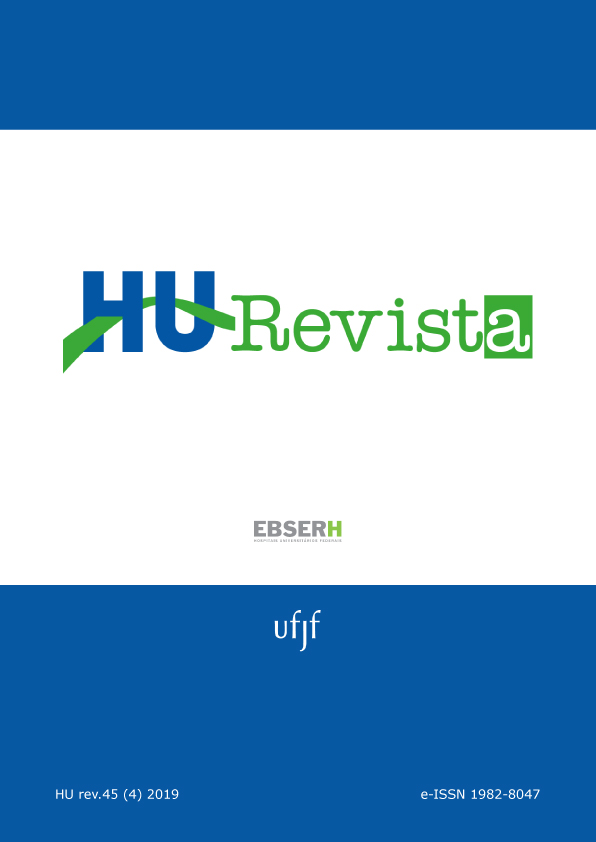Photobiomodulation therapy in the treatment of Stevens-Johnson syndrome oral lesions: case report
DOI:
https://doi.org/10.34019/1982-8047.2019.v45.25799Keywords:
Stevens-Johnson Syndrome, Stomatitis, Pain, Low-Level Light Therapy, Wound HealingAbstract
Introduction: Stevens-Johnson Syndrome is a rare reaction manifested by a rash that evolves into extensive epidermal dislocation. In most cases there are painful oral mucosal lesions that can reduce nutrient intake and make oral hygiene difficult. Photobiomodulation therapy can play an important antalgic role in modulating inflammation and healing these lesions. Objective: To report a clinical case in which Stevens-Johnson Syndrome oral lesions were treated with the aid of photobiomodulation therapy. Case report: A 17-year-old female patient diagnosed with Stevens-Johnson syndrome presented with lip edema, oral ulcers, fever, and severe odynophagia, tolerating only a liquid diet. She experienced reduced food intake, no efficient oral communication, and an interruption of oral hygiene due to intense pain. Photobiomodulation therapy was requested to treat the oral lesions. Conclusion: Photobiomodulation therapy helped reduce pain, favored oral food intake, and reduced lesion healing time.
Downloads
References
French LE. Toxic epidermal necrolysis and Stevens Johnson syndrome: our current understanding. Allergol Int. 2006; 55(1):9-16.
Parveen S, Javed MA. Stevens Johnson Syndrome associated with lamotrigine. Pak J Med Sci. 2013; 29(6):1450-52.
Stitt Jr. VJ. Stevens-Johnson syndrome: a review of the literature. J Natl Med Assoc. 1988; 80(1):104-8.
Karu T, Pyatibrat L, Kalendo G. Irradiation with He-Ne laser increases ATP level in cells cultivated in vitro. J Photochem Photobiol B. 1995; 27(3):219-223.
Pourreau-Schneider N, Ahmed A, Soudry M, Jacquemier J, Kopp F, Franquin JC et al. Helium-Neon laser treatment transforms fibroblastos into myofibroblasts. Am J Pathol. 1990; 137(1):171-8.
Almeida-Lopes L, Rigau J, Zângaro RA, Guidugli-Neto J, Jaeger MMM. Comparison of the low level laser therapy effects on cultured human gingival fibroblasts proliferation using different irradiance and same fluence. Lasers Surg Med. 2001; 29(2):179-184.
Sperandio FF, Simões A, Corrêa L, Aranha ACC, Giudice FS, Hamblin MR, et al. Low-level laser irradiation promotes the proliferation and maturation of keratinocytes during epithelial wound repair. J Biophotonics. 2015; 8(10):795-803.
Bjordal JM, Johnson MI, Iversen V, Aimbire F, Lopes-Martins RAB. Low-level laser therapy in acute pain: a systematic review of possible mechanisms of action and clinical effects in randomized placebo-controlled trials. Photomed Laser Surg. 2006; 24(2):158-68.
Simões A, Freitas PM, Bello–Silva MS, Tunér J, Eduardo CP. Laser phototherapy for Stevens–Johnson syndrome: a case report. Photomed Laser Surg. 2011; 29(1):67-9.
Creamer D, Walsh SA, Dziewulski P, Exton LS, Lee HY, Dart JKG et al. UK guidelines for the management of Stevens-Johnson syndrome/toxic epidermal necrolysis in adults 2016. J Plast Reconstr Aesthet Surg. 2016; 69(6):e119-e153.
Harr T, French LE. Toxic epidermal necrolysis and Stevens-Johnson syndrome. Orphanet J Rare Dis. 2010; 5(39). doi: 10.1186/1750-1172-5-39
Campos L, Cruz EP, Pereira FS, Arana-Chavez VE, Simões A. Comparative study among three different phototherapy protocols to treat chemotherapy-induced oral mucositis in hamsters. J Biophotonics. 2016; 9(11-12):1236-45.
Rocha AL, Souza AF, Nunes LFM, Cunha NDS, Lanza CRM, Travassos DV et al. Treatment of oral manifestations of toxic epidermal necrolysis with low‐level laser therapy in a pediatric patient. Pediatr Dermatol. 2019; 36(1):e27–e30. doi: 10.1111/pde.13719
Downloads
Published
How to Cite
Issue
Section
License
Cessão de Primeira Publicação à HU Revista
Os autores mantém todos os direitos autorais sobre a publicação, sem restrições, e concedem à HU Revista o direito de primeira publicação, com o trabalho licenciado sob a Licença Creative Commons Attribution que permite o compartilhamento irrestrito do trabalho, com reconhecimento da autoria e crédito pela citação de publicação inicial nesta revista, referenciando inclusive seu DOI.









